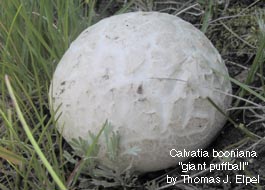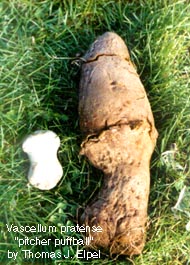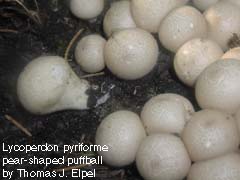
Lycoperdaceae: The True Puffball Family
Puffball mushrooms have a one- or two-layered skin, forming a ball-like structure with the spores enclosed inside. The mushrooms are white and firm inside when young, but gradually turn to a mass of brown, powdery spores as they mature and dry. The spores are released through a pore in the top or released when the outer skin crumbles away. I always liked to squeeze the little dried puffballs to see the spores puff out like smoke. The dry spores can be used as a coagulant to help stop bleeding, as my grandmother once did to help stop the bleeding on a wounded horse.
 All members of the True Puffball Family are considered edible, but be sure to cut the young ones open to make sure there are no gills hidden inside. The deadly amanitas have a volva or "universal veil" that completely envelopes the young mushrooms. Before bursting forth from the volva, they look like little round puffball mushrooms. You have to cut open each little puffball to make sure there are no gills inside--otherwise your life might just go puff before your eyes! I was sure shocked the first time I saw an amanita in this stage, because I too was sure I had a puffball.
All members of the True Puffball Family are considered edible, but be sure to cut the young ones open to make sure there are no gills hidden inside. The deadly amanitas have a volva or "universal veil" that completely envelopes the young mushrooms. Before bursting forth from the volva, they look like little round puffball mushrooms. You have to cut open each little puffball to make sure there are no gills inside--otherwise your life might just go puff before your eyes! I was sure shocked the first time I saw an amanita in this stage, because I too was sure I had a puffball.
The giant puffball (Calvatia booniana) pictured above is typical of puffballs found on western rangelands. The mushrooms can be smaller than a fist, or so large that you can hardly lift them. The eight-inch specimen pictured here is very typical of the species. I eat the mushrooms when I find them on camping trips. The mushrooms can be sliced into large white "steaks" and fried in oil or butter, or cut into cubes and added to stews. It is definitely not my favorite mushroom for flavor, but I'll gladly eat it when other mushrooms are not available.
 The pitcher puffball (Vascellum pratense) pictured on the right was found near the creek in our little town of Pony, Montana. There is a papery membrane separating the sterile stalk from the spore mass above it, which is located at break in the middle of the dried specimen in the picture. This mushroom was unusually large for this species.
The pitcher puffball (Vascellum pratense) pictured on the right was found near the creek in our little town of Pony, Montana. There is a papery membrane separating the sterile stalk from the spore mass above it, which is located at break in the middle of the dried specimen in the picture. This mushroom was unusually large for this species.
The pear-shaped puffballs (Lycoperdon pyriforme) shown here on the left were found up Indian Creek, near Sheridan, Montana. Pear-shaped puffballs typically grow on rotten wood, but sometimes may seem to sprout from the soil, which usually indicates there is wood or the remains of wood buried in the soil.
References:
Arora, David. All That the Rain Promises, and More... Ten Speed Press: Berkeley, CA. 1991.
Arora, David. Mushrooms Demystified, Second Edition. Ten Speed Press: Berkeley, CA. 1986.
Phillips, Roger. Mushrooms of North America. Little, Brown & Co.: Boston. 1991.
Schalkwijk-Barendsen, Helene M.E. Mushrooms of Northwest North America. Lone Pine Publishing: Redmond, WA. 1991.
-Check out my favorite mushroom guides.-
Return to the Wildflowers & Weeds Home Page.





 Wildflowers-and-Weeds.com
Wildflowers-and-Weeds.com 
 All members of the True Puffball Family are considered edible, but be sure to cut the young ones open to make sure there are no gills hidden inside. The
All members of the True Puffball Family are considered edible, but be sure to cut the young ones open to make sure there are no gills hidden inside. The  The pitcher puffball (Vascellum pratense) pictured on the right was found near the creek in our little town of Pony, Montana. There is a papery membrane separating the sterile stalk from the spore mass above it, which is located at break in the middle of the dried specimen in the picture. This mushroom was unusually large for this species.
The pitcher puffball (Vascellum pratense) pictured on the right was found near the creek in our little town of Pony, Montana. There is a papery membrane separating the sterile stalk from the spore mass above it, which is located at break in the middle of the dried specimen in the picture. This mushroom was unusually large for this species.





